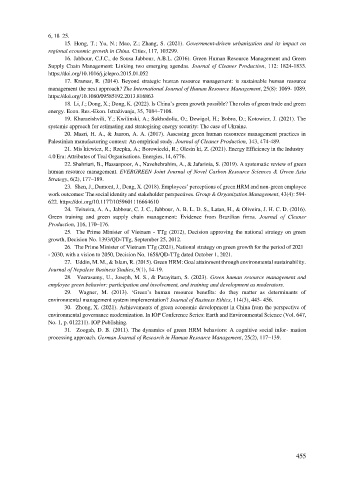Page 463 - Ebook HTKH 2024
P. 463
6, 18–25.
15. Hong, T.; Yu, N.; Mao, Z.; Zhang, S. (2021). Government-driven urbanization and its impact on
regional economic growth in China. Cities, 117, 103299.
16. Jabbour, C.J.C., de Sousa Jabbour, A.B.L. (2016). Green Human Resource Management and Green
Supply Chain Management: Linking two emerging agendas. Journal of Cleaner Production, 112: 1824-1833.
https://doi.org/10.1016/j.jclepro.2015.01.052
17. Kramar, R. (2014). Beyond strategic human resource management: is sustainable human resource
management the next approach? The International Journal of Human Resource Management, 25(8): 1069- 1089.
https://doi.org/10.1080/09585192.2013.816863
18. Li, J.; Dong, X.; Dong, K. (2022). Is China’s green growth possible? The roles of green trade and green
energy. Econ. Res.-Ekon. Istraživanja, 35, 7084–7108.
19. Kharazishvili, Y.; Kwilinski, A.; Sukhodolia, O.; Dzwigol, H.; Bobro, D.; Kotowicz, J. (2021). The
systemic approach for estimating and strategising energy security: The case of Ukraine.
20. Masri, H. A., & Jaaron, A. A. (2017). Assessing green human resources management practices in
Palestinian manufacturing context: An empirical study. Journal of Cleaner Production, 143, 474-489.
21. Mis ́kiewicz, R.; Rzepka, A.; Borowiecki, R.; Olesin ́ki, Z. (2021). Energy Efficiency in the Industry
4.0 Era: Attributes of Teal Organisations. Energies, 14, 6776.
22. Shahriari, B., Hassanpoor, A., Navehebrahim, A., & Jafarinia, S. (2019). A systematic review of green
human resource management. EVERGREEN Joint Journal of Novel Carbon Resource Sciences & Green Asia
Strategy, 6(2), 177–189.
23. Shen, J., Dumont, J., Deng, X. (2018). Employees’ perceptions of green HRM and non-green employee
work outcomes: The social identity and stakeholder perspectives. Group & Organization Management, 43(4): 594-
622. https://doi.org/10.1177/1059601116664610
24. Teixeira, A. A., Jabbour, C. J. C., Jabbour, A. B. L. D. S., Latan, H., & Oliveira, J. H. C. D. (2016).
Green training and green supply chain management: Evidence from Brazilian firms. Journal of Cleaner
Production, 116, 170–176.
25. The Prime Minister of Vietnam - TTg (2012), Decision approving the national strategy on green
growth, Decision No. 1393/QD-TTg, September 25, 2012.
26. The Prime Minister of Vietnam TTg (2021), National strategy on green growth for the period of 2021
- 2030, with a vision to 2050, Decision No. 1658/QD-TTg dated October 1, 2021.
27. Uddin, M. M., & Islam, R. (2015). Green HRM: Goal attainment through environmental sustainability.
Journal of Nepalese Business Studies, 9(1), 14-19.
28. Veerasamy, U., Joseph, M. S., & Parayitam, S. (2023). Green human resource management and
employee green behavior: participation and involvement, and training and development as moderators.
29. Wagner, M. (2013). ‘Green’s human resource benefits: do they matter as determinants of
environmental management system implementation? Journal of Business Ethics, 114(3), 443- 456.
30. Zhong, X. (2021). Achievements of green economic development in China from the perspective of
environmental governance modernization. In IOP Conference Series: Earth and Environmental Science (Vol. 647,
No. 1, p. 012211). IOP Publishing.
31. Zoogah, D. B. (2011). The dynamics of green HRM behaviors: A cognitive social infor- mation
processing approach. German Journal of Research in Human Resource Management, 25(2), 117–139.
455

